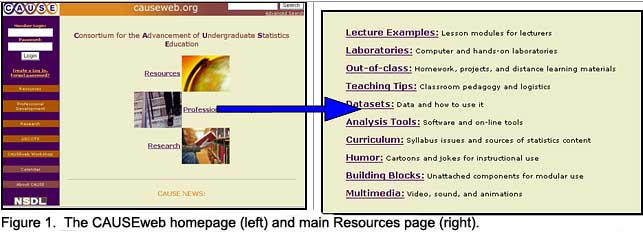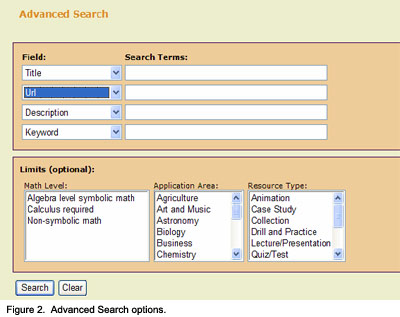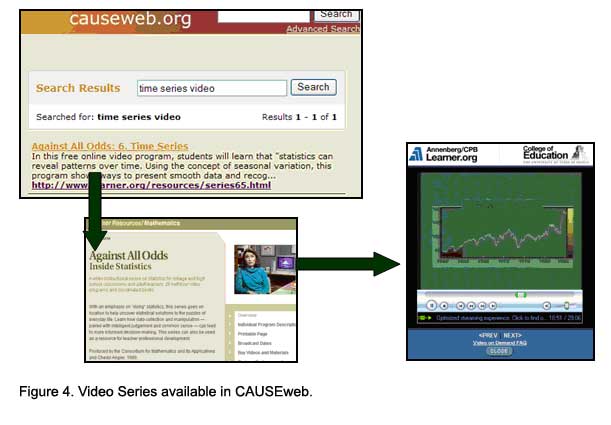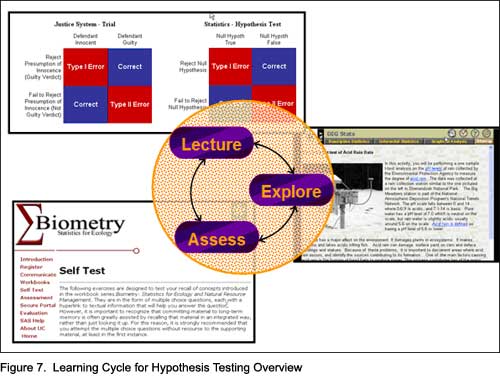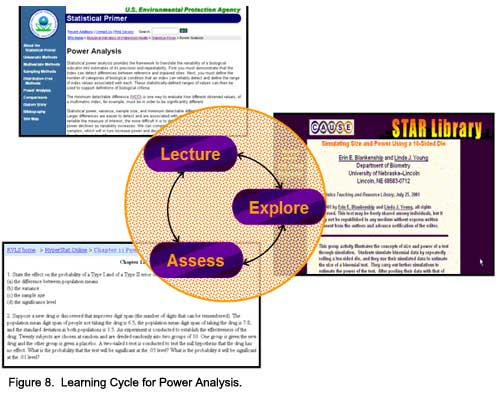 |
Introduction There are several circumstances in which non-statisticians teach statistical concepts. This could be an entire course, for example in a business or psychology department, or it could be just a few lessons during a course, for example in a laboratory class in a science department. Even a statistics class in a mathematics department might be taught by a professor with little or no experience in statistics. Not having an extensive background in statistics, these teachers may not feel comfortable creating new lesson plans or anticipating which topics will confuse their students. More experienced colleagues could be a resource for these teachers, but in a non-mathematics or statistics department, such colleagues may not be available. The Internet is a good place to turn for information on the teaching and learning of statistics. However, while there are certainly very good statistics websites, these can get lost in the sheer number of other sites that are returned when a search on a key term is made. CAUSEweb is an online resource for undergraduate statistics education. One part of this site is a catalogued collection of statistical resources, such as lecture examples, datasets, and applets. This collection contains items that have been selected for accuracy and for helpfulness in teaching various topics in statistics. Furthermore, an advanced search capability allows searching on keywords, resource type, and application area. This resource can be used to plan lectures, to give students an opportunity to explore statistical concepts, and to create assessments of students’ learning. This paper provides examples of using such statistical education online resources in a variety of disciplines. Non-statisticians teaching statistics Experienced teachers learn which topics students tend to have difficulty with and accumulate techniques to address these problems. However, professors new to a course do not have the benefit of the experience of having previously taught these concepts. Also, a traditional resource for a new professor, the colleague down the hall, may not help if the colleague is equally new to the discipline of statistics. It is clear that non-statisticians responsible for teaching statistics are interested in doing a high-quality job. A brief search on Journal Storage: The Scholarly Journal Archive (JSTOR) found articles on teaching statistics in econometrics journals and political science journals, among others, and a book review for a book aimed at archaeologists (Becker & Greene, 2001; Carlson, 1999; Lock, 1997; McBride, 1996). A search of recent grants awarded by NSF found over 50 that were supporting teaching statistics in a discipline such as psychology, engineering, and business. Lesson plans, tutorials, case studies, applets, and other teaching resources are available on the Internet. It is important, though, that resources for new teachers be both easily accessible and easy to use. Some web pages contain information that requires proprietary software to use. Other pages require fees to access the material. Still others contain factually incorrect information or present correct information in a confusing way. Teachers searching for resources on the Internet should have a way to narrow their search, so that only items that will be useful are returned.
A resource that will help with this problem for statistics teachers is CAUSEweb, a digital library of online learning materials for undergraduate statistics education. CAUSE, the Consortium for the Advancement of Undergraduate Statistics Education, is a national organization which arose from an initiative of the American Statistics Association. It has a four-pronged strategy to support and enhance undergraduate statistics education: 1) resources, 2) professional development, 3) outreach, and 4) research. This consortium has over 40 members who are committed to promoting and improving undergraduate statistics education. These individuals represent a wide array of institutions ranging from research universities, to liberal arts colleges, to community colleges, and even businesses and industry. CAUSEweb is the one-stop shopping website that supports CAUSE’s mission. This site contains information about all of CAUSE’s programs, resources for instructors, information about professional development in the field of undergraduate statistics education, and information about current research in this field. The screenshot on the left of Figure 1 shows the homepage of CAUSEweb. This paper will focus on the Resources facet of CAUSEweb, the opening page of which is shown on the right of Figure 1. (Note: All of the screenshots used in this paper have been used with permission from the author, organization or publisher.) Use of the CAUSEweb site does not require membership, but membership at CAUSEweb’s site is free and provides added features such as submitting a resource, joining forums, and setting account preferences. In the future, these account preferences will provide a means of notification to the user when new materials that meet pre-specified requirements are entered in the database and will provide a means of filtering out items that do not meet your preferences.
The statistics education resources found when searching CAUSEweb are of two types: peer-reviewed learning materials and carefully selected learning objects which already exist on the web, hereafter referred to as “on-the-web”. CAUSEweb has formed a partnership with the well established Multimedia Educational Resources for Learning and Online Teaching (MERLOT) community, and together they have created one review process for online materials in statistics education (Multimedia Educational Resource for Learning and Online Teaching, 2005).The peer-reviewed learning objects in the site are reviewed by three reviewers on the Editorial Board (http://www.causeweb.org/about/) in a double blind review process. The learning objects are compared to the Review Criteria and Editorial Standards which include quality of content, likely effectiveness as a teaching-learning tool, and ease of use. (See http://www.causeweb.org/resources/criteria.php for complete details.) A composite review is written and appears on the webpage describing the resource. This allows users to see how other statistics educators would integrate the resource into a class and allows them to quickly assess if the item is appropriate for their specific needs. At this time, peer-reviewed materials in CAUSEweb are denoted with a double-star symbol, which will be replaced with a different icon in the future. Since CAUSEweb is still a new digital library, the collection of peer-reviewed materials is growing, and potential users of CAUSEweb are encouraged to check the site regularly to learn of newly added peer-reviewed materials. Moreover, there are over 1000 carefully selected items in the on-the-web section of CAUSEweb. Because it is currently the larger part of CAUSEweb, the examples in this paper are, in general, taken from the on-the-web section. All learning objects in the CAUSEweb digital library (both peer-reviewed and on-the-web materials) include helpful information for end-users to quickly assess the appropriateness of the item for their needs. The information includes identifying information such as title, URL, author information, and description. Also included is information about applicability of the resource, such as the type of material it is, suggested uses for the resources in class, statistical topic, application area if appropriate, mathematical level, and technical requirements. The “material type” field classifies the resource by how it would typically be used: lecture example, laboratory activity, dataset, etc. A similar field, labeled “resource type,” describes the resource: simulation, case study, quiz/test, etc. The “statistical topic,” “application area,” and “mathematical level” fields allow for searching according to a taxonomy of statistical topics, application area, and whether the resource is suitable for an audience in high school, lower-level undergraduate, or upper-level undergraduate. The application areas included are agriculture, art and music, astronomy, biology, business, chemistry, computer science, engineering, geology, health science, humanities, mathematics, physics, political science, psychology, and sociology, as well as sports and games. There is a search feature in the upper right corner of the main CAUSEweb screen. Users can perform a basic search by typing key words into this box. Additionally, a more comprehensive search capability is available by clicking on the phrase “advanced search.” Figure 2 demonstrates the advanced search feature. CAUSEweb indexes many useful websites for teachers of statistics. Sites include a variety of materials including questions that can be used for quizzes, tests, or homework; information that can be used to supplement (or even replace) the textbook in a course; and case studies, java applets, or statistical calculation tools. A few of the more notable sites accessible through CAUSEweb will be described in more detail below. A teacher looking for useful quiz or test questions for introductory statistics would do well to start with the Assessment Resource Tools for Improving Statistical Thinking (ARTIST) database (Garfield et al., 2002). This site includes an extensive searchable database of introductory statistics questions indexed by topic and type of question. Questions can also be found in the Hyperstat Online site, a sub-site for the Rice Virtual Lab in Statistics (Lane, 2000) . Information to supplement a textbook can be found at Hyperstat Online, The NIST Engineering Statistics Handbook (NIST/SEMATECH e-Handbook of Statistical Methods, 2005) and DIG Stats (Morgan & Kriz, 2002a). These are all online books. The Hyperstat Online site is in outline form, with brief descriptions of statistical concepts linking to other topics and websites that might be of interest and includes exercises at the end of each chapter. The Engineering Statistics Handbook was created by the National Institute for Standards and Technology and is designed for scientists and engineers. It does not contain exercises but does contain well written explanations of concepts as well as case studies. DIG Stats is an online textbook designed for active learning, in which each chapter is paired with activities, datasets, and case studies that demonstrate the concepts. Additionally, DIG Stats provides detailed instructions for completing activities using the TI-83 graphing calculator and Microsoft Excel. Applets and statistical tools can be found at The Rice Virtual Lab in Statistics (Lane, 2000), the Statistical Java site (S.Dorai-Raj et al., 2002), StatCrunch (West, 2005), and the VassarStats site (Lowry, 2005). The Rice Virtual Lab and the Statistical Java site contain applets and simulations that demonstrate statistical concepts. The VassarStats site provides free tools for online calculation of statistical quantities. StatCrunch is a freely available full-featured menu-driven data analysis package that runs entirely in a web browser. Using Online Resources in a Lesson Knowing which sites are available is a large step toward using these resources. However, determining appropriate uses for online materials is also an important part of the process. The following section describes an approach for planning a lesson using such resources. This process will be described using what will be referred to as the learning cycle and examples will be provided which demonstrate a variety of disciplines. In order to cover more disciplines, each learning cycle example will not be limited to topics in one discipline. Learning Cycle In order to clarify how a teacher would use CAUSEweb to prepare to cover a topic, consider the following useful model of the activity of teaching, the learning cycle. A representation of the learning cycle is provided in Figure 3. If a topic is new to a class, the teacher might introduce it using a traditional lecture, a movie, an applet, etc. Items in which the teacher is directing the students’ attention are classified under the heading “Lecture.” Once the topic has been introduced, understanding can be furthered by having the students do an in-class activity, assigning homework, exploring a simulation or applet, or completing a case study. Such activities that are student-driven are grouped under the heading “Explore.” Finally, the amount of learning that has occurred must be measured. Student-driven self-tests and questions that teachers can put on quizzes or tests are grouped under the heading “Assess.” These terms are put in a cycle representation to avoid the implication that first a teacher lectures, then students explore, and then learning is measured. Instead, these can happen in any order, and each type of activity can be repeated several times. Furthermore, there is quite a bit of overlap between the categories. For example, a teacher might introduce a lecture with a case study, or have students explore a concept with a case study. Similarly, a laboratory activity could be considered an exploration or an assessment, depending on the intent of the teacher. This learning cycle model is simply a convenient way of classifying teaching activities. The following examples will demonstrate how the use of CAUSEweb can fit in to any portion of this cycle. Examples The first example begins with a teacher wanting to use web-based resources to teach time series to a business statistics class. The teacher wants to give students some initial information to help them understand the basics of time series and also wants to capitalize on many of the technologies on the Internet in order to keep the students involved and engaged in the material. Example 1: A Business Statistics Class Studying Time Series Lecture: The teacher remembers hearing from a colleague that there is a video available which presents realistic information about time series and thinks that this would be a good motivational approach for teaching a lesson on time series. This first example will include information about searching for these items in CAUSEweb. Going to www.causeweb.org, the instructor searches for a video on time series by entering time series video in the search box. Using this detailed search criterion, only one learning resource, Against All Odds (The Annenberg Foundation, 1989), is found to meet the description. Selecting the learning object title provides a screen with additional information about the resource, while clicking on the web address takes the user directly to the website of interest. From here the instructor can select the video on time series. This process is demonstrated in Figure 4. This free online video can be shown in class if an Internet connection and a computer projection system are available, or it can be given as an out-of-class homework assignment. This particular video has animations and uses stock market trends, among other things, to explore time series.
Explore. After showing all or part of the video in class, the teacher may want to have students explore on their own, for example, how differences in the data will affect the overall trend and equation. Typing in time series applet in the simple search feature of CAUSEweb results in several choices. Selecting one of these, Interactive Applet: Times Series Forecasting (Accelet Corp, 2004), takes the teacher to a website with an embedded applet. Using this applet, students are able to deepen their understanding of time series forecasting by adjusting the data points, by changing the data in the table, or by even adding their own data to the table. The applet immediately adjusts the corresponding time series equation and forecasting line to model the new data. The teacher could write specific instructions to accompany the applet or could allow the student independent exploration. This learning object could be used in class, in a computer laboratory setting, or with appropriate instruction could be assigned for homework. Alternatively, this exploration could be used by a teacher as a part of a lecture. Assess. When looking for questions on assessing topics such as time series, regression, etc., the instructor could go directly to the ARTIST database (Garfield et al., 2002). If the teacher wants to make sure that questions are placed in a business setting, another option is to type the broader search term of business quiz in CAUSEweb’s simple search feature. The combination of the application area (business) and the desired type of item (quiz) produces a narrow list of assessment options for business. One option, Practice Questions for Business Statistics, offers an extensive assessment site for business statistics (Schott, 1997). The teacher can select the chapter that contains the statistical topic of interest, which would be Regression Analysis for this example. The result is over 70 questions, with answers, from which the teacher can select the ones appropriate for the given class assessment. These assessment items could be used as a self-test for the students, as a quiz, or on a formal test. The entire learning cycle using these resources can be viewed in Figure 5.space="0" vspace="0" align="middle">
Example 2: A Complete Course from One Website Many of the sites in CAUSEweb have everything needed to complete the learning cycle on a given statistical topic in one Internet site. One such site which contains several coursesThe MIT Open courseware site proves to be a veritable gold mine for resources. This project contains many courses, some that do and some that do not contain statistics. All of the courses that involve statistics and probability are indexed in CAUSEweb. This learning cycle example will demonstrate how the Computing and Data Analysis for Environmental Applications course (Massachusetts Institute of Technology, 2003a) contains an entire learning cycle of statistical resources (Figure 6). Lecture. On the Computing and Data Analysis for Environmental Applications site (Massachusetts Institute of Technology, 2003a) there are 23 separate lecture files that are easily downloadable and printable as a PDF. These files can easily be integrated into a lecture as handouts or can be shown to the class on a visual presenter or a computer. Explore. The same site contains an example on environmental applications in statistics. This example contains two methods for exploring. If a teacher wants to integrate some computer applications into a course, there are several detailed ideas provided that even include supporting MATLAB files. Of course, one of the best ways to explore is for students to work good classwork or homework problems. This site contains a plethora of unique and interesting problems that will pique students’ interest and allow them to explore what they know about environmental applications of statistics. Assess. Similar to the good problem sets mentioned above, this all-in-one site contains authentic non-routine problems that also include solutions. These PDF files can be given out as the actual exam, or one could select a subset of questions to add to their own database of questions.
Example 3: Hypothesis Testing Overview, Demonstrating Various Application Areas Lecture: Searching CAUSEweb for lecture material that provides a general overview of hypothesis testing results in a link to a webpage on the Intuitor site (Rogers, 2001), among other possible choices. This page contains an explanation of null and alternate hypotheses as well as Type I and Type II errors, comparing hypothesis testing to a criminal trial. This explanation can help a teacher explain how the probability of each type of error depends on the structure of the hypothesis test and the assumptions underlying the alternate hypothesis. Explore: A second search results in the DIG Stats site (Morgan & Kriz, 2002b). As previously described, this site contains many resources for directing active learning. Among these is an explanation of how to perform a t-test. This specific type of hypothesis test can be used to teach the mechanics, rather than the theory, of hypothesis testing. DIG Stats also has a page explaining how to use a TI-83 calculator in performing a t-test (Morgan & Kriz, 2002c). Finally, there are two case studies that use a t-test. One of these analyzes the rainfall in a particular region to determine if it is acid rain (Morgan & Kriz, 2002e). The other is an analysis of historic speed-of-light data (Morgan & Kriz, 2002d). The choice of case study can be made based on the background of the student involved, or one case study can be done as a class exercise and the other assigned as homework. Assess: Finally, a CAUSEweb search for hypothesis test questions results in a site with a self-test for students ("Biometry--Statistics for Ecology: Self Test"). This site contains questions on many topics, including hypothesis testing. Students can answer the questions and have their answers automatically assessed by the site on the Internet. The self-test also contains links to pages explaining the ideas behind each question for students who are unsure. A teacher could also decide to use these questions in an in-class test rather than having students use the site as a self-test. Figure 7 shows portions of these websites placed in a learning cycle.
Example 4: Power Analysis, Demonstrating Various Application Areas For a more in-depth look at a sub-topic in hypothesis testing, consider power analysis. The power of a hypothesis test depends on the structure of the test (for example, the rejection region and sample size) as well as the assumptions made about the alternate hypothesis. Power is a difficult topic to teach, partly because it is possible to correctly perform a hypothesis test without knowing how powerful it is. It is therefore difficult to convince students that power is an important topic to spend their energy on. Lecture: A search in CAUSEweb for lecture materials on power results in a webpage from the Environmental Protection Agency that explains why power analysis is useful (US Environmental Protection Agency, 2002). This page discusses the need to detect differences in environmental quality between reference locations and impaired sites. It relates statistical power to the concept of a minimum detectable difference. Explore: Another search in CAUSEweb for statistical power yields an in-class activity, “Simulating Size and Power Using a 10-Sided Die,” from the STAR Library (Blankenship & Young, 2001). The hypothesis test in this activity is designed to see if a certain treatment results in a higher proportion of female calves being born than male calves. The activity consists of students tossing ten-sided dice and considering sample size and power. The on-line materials include a description for the teacher of how to run the class, a handout for the students to work from, a description of where to get ten-sided dice and a comment on how to change the project if a different randomization device is used. Assess: Finally, searching for exercises on power leads us to the chapter on power in the HyperStat website (Lane, 2003). It contains several short-answer exercises on power and a link to selected answers. It also contains information on how to calculate power, the relationship between power and sample size, and other factors affecting power.
A variety of types of resources has been represented in the above examples (see Figure 8). A movie, useful information typically not found in a textbook, and a visual aid for class were selected for the lecture part of the learning cycle. To demonstrate how students might explore statistical concepts, an applet, an in-class activity, and a case study were presented. To assist teachers in assessing student learning, sites were shown which provide student-self tests as well as teacher directed exam questions. Also, the examples were purposefully selected to cover a variety of different application areas. One example showcased statistical methods associated with environmental applications and another focused on business statistics using time series. Single learning objects were described which had application areas of biology, chemistry, and criminal justice. Of course, other application areas could have been chosen. Conclusion References Accelet Corp. (2004). Time series forecasting. Retrieved August 15, 2005, from http://highered.mcgraw-hill.com/sites/dl/free/0072868244/124727/LinearTE.html The Annenberg Foundation. (1989). Against all odds: Inside statistics. Retrieved August 19, 2005, from http://www.learner.org/resources/series65.html Massachusetts Institute of Technology. (2003b). MIT OpenCourseWare. Retrieved August 30, 2005, from http://ocw.mit.edu/OcwWeb/index.htm McBride, A. B. (1996). Creating a critical thinking learning environment: Teaching statistics to social science undergraduates. Political Science and Politics, 29(3), 517-521. Morgan, T., & Kriz, R. (2002a). DIG Stats. Retrieved August 30, 2005, from http://www.cvgs.k12.va.us/DIGSTATS/index.html Morgan, T., & Kriz, R. (2002b). DIG Stats: Sitemap. Retrieved August 15, 2005, from http://www.cvgs.k12.va.us/DIGSTATS/Sitemap.html Morgan, T., & Kriz, R. (2002c). Guide for performing a T-Test on the TI-83. Retrieved August 30, 2005, from http://www.cvgs.k12.va.us/DIGSTATS/main/Guides/g_ttstt.html Morgan, T., & Kriz, R. (2002d). One-sample t test of Speed of Light Data. Retrieved August 15, 2005, from http://www.cvgs.k12.va.us/DIGSTATS/main/inferant/a_lightnew.htm Morgan, T., & Kriz, R. (2002e). One sample t-test of Acid Rain Data. Retrieved August 15, 2005, from http://www.cvgs.k12.va.us/DIGSTATS/main/inferant/a_acidrain.htm Multimedia Educational Resource for Learning and Online Teaching. (2005). Retrieved August 5, 2005, from https://www.merlot.org/ NIST/SEMATECH e-Handbook of Statistical Methods. (2005, January 26). Retrieved August 30, 2005, from http://www.itl.nist.gov/div898/handbook/index.htm Rogers, T. (2001). Type I and Type II errors - Making mistakes in the justice system. Retrieved August 15, 2005, from http://www.intuitor.com/statistics/T1T2Errors.html S.Dorai-Raj, C.Anderson-Cook, & T.Robinson. (2002). Statistical java. Retrieved August 30, 2005, from http://kitchen.stat.vt.edu/~sundar/java/applets/ Schott, B. (1997). Practice Questions for Business Statistics. Retrieved August 19, 2005, from http://www2.gsu.edu/~dscbms/ibs/qcontent.html US Environmental Protection Agency. (2002). Power Analysis. Retrieved August 15, 2005, from http://www.epa.gov/bioindicators/primer/power.html West, W. (2005). Statcrunch. Retrieved August 30, 2005, from http://www.statcrunch.com/
|
| Copyright © 2005 MERLOT. All Rights Reserved. Portions Copyright by MERLOT Community Members. Used with Permission. |
Questions? Email: jolteditor@merlot.org Last Modified : 2005/04/14 |
